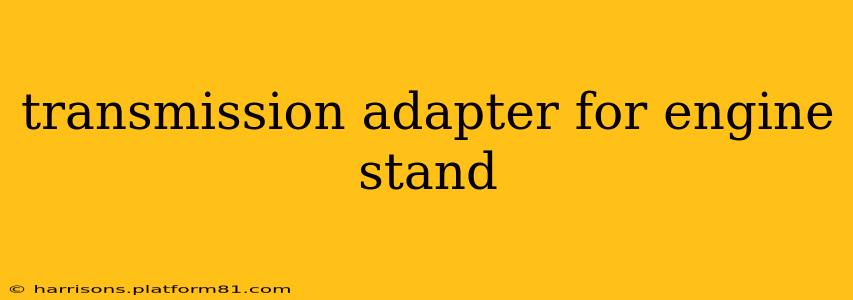Working on engine rebuilds or repairs often requires securing the transmission separately from the engine. This is where a transmission adapter for an engine stand becomes invaluable. This comprehensive guide will delve into everything you need to know about these essential tools, helping you choose the right one for your project and ensuring safe, efficient work.
What is a Transmission Adapter for an Engine Stand?
A transmission adapter is a specialized attachment for an engine stand designed to securely hold a transmission during maintenance, repair, or rebuild. They are crucial because transmissions are heavy, awkward to handle, and require stable support to prevent damage. Unlike an engine, which often has convenient lifting points, transmissions need a specifically designed cradle for secure support. These adapters provide this crucial support, allowing technicians to work on the transmission safely and efficiently.
Why Use a Transmission Adapter?
Using a transmission adapter offers several key advantages:
- Safety: Transmissions are heavy and unwieldy. An adapter prevents accidental drops, protecting both the transmission and the technician.
- Stability: The adapter provides a stable platform for working on the transmission, minimizing the risk of damage during repairs.
- Accessibility: Proper support allows for better access to all parts of the transmission during disassembly, inspection, and reassembly.
- Efficiency: A secure and stable workspace streamlines the repair process, saving you time and frustration.
What Types of Transmission Adapters Are Available?
Transmission adapters vary depending on the type of transmission and engine stand. Common types include:
- Universal Adapters: These are designed to fit a wide range of transmission types and engine stands. They often feature adjustable clamps and mounts. While offering versatility, they may not provide the same level of specific support as dedicated adapters.
- Specific Adapters: These are designed for specific makes and models of transmissions. They provide a snug, secure fit, optimizing support and stability. However, they lack the versatility of universal adapters.
- Bolt-on Adapters: These adapters directly bolt onto the engine stand, offering a robust and permanent solution for those who frequently work on the same type of transmission.
How to Choose the Right Transmission Adapter?
Selecting the correct transmission adapter hinges on these factors:
- Transmission Type: Identify the make, model, and year of the transmission. A dedicated adapter designed for that specific transmission will offer the best support.
- Engine Stand Compatibility: Ensure the adapter is compatible with your existing engine stand. Check the specifications of both the adapter and the stand to verify compatibility.
- Weight Capacity: The adapter must have a weight capacity sufficient to handle the weight of the transmission. Always select an adapter with a higher weight capacity than the actual weight of the transmission to ensure ample safety margin.
- Material and Construction: Look for adapters made from durable, high-quality materials that can withstand the stresses of holding a heavy transmission. Robust construction is crucial for safety.
What are the potential problems with using an unsuitable adapter?
Using an unsuitable adapter can lead to:
- Transmission Damage: An improperly supported transmission is susceptible to damage during handling and repairs.
- Injury: An unsecured transmission can fall, causing serious injury to the technician.
- Inefficient Work: A poorly fitting adapter can hinder access to the transmission components, slowing down the repair process.
How do I safely mount a transmission on an engine stand using an adapter?
Always consult your specific adapter and engine stand instructions for detailed steps. Generally, the process involves:
- Secure the Adapter: Firmly attach the transmission adapter to your engine stand according to the manufacturer's instructions.
- Position the Transmission: Carefully lift and position the transmission onto the adapter.
- Secure the Transmission: Use the adapter's clamping mechanisms to secure the transmission firmly.
- Double-Check Stability: Before proceeding, ensure the transmission is securely mounted and stable.
By carefully selecting and utilizing a transmission adapter, you can significantly enhance safety, efficiency, and the overall success of your engine and transmission repair projects. Remember to always prioritize safety and follow manufacturer instructions.
